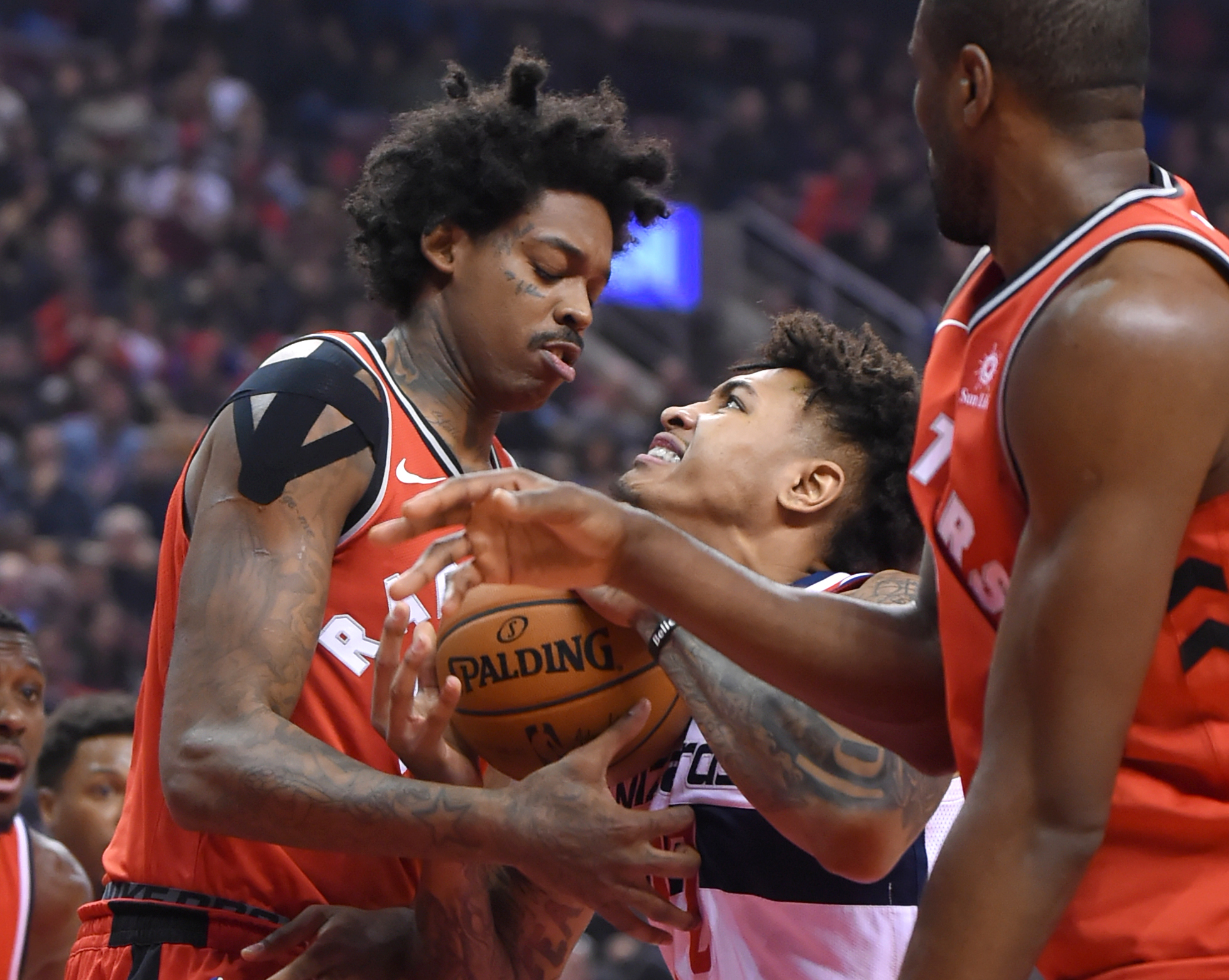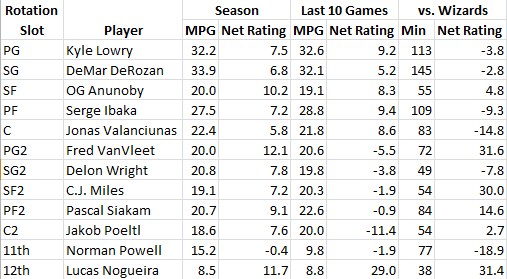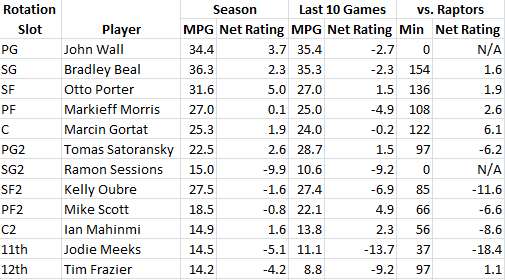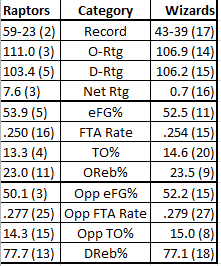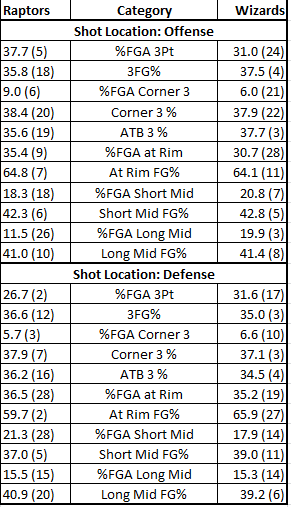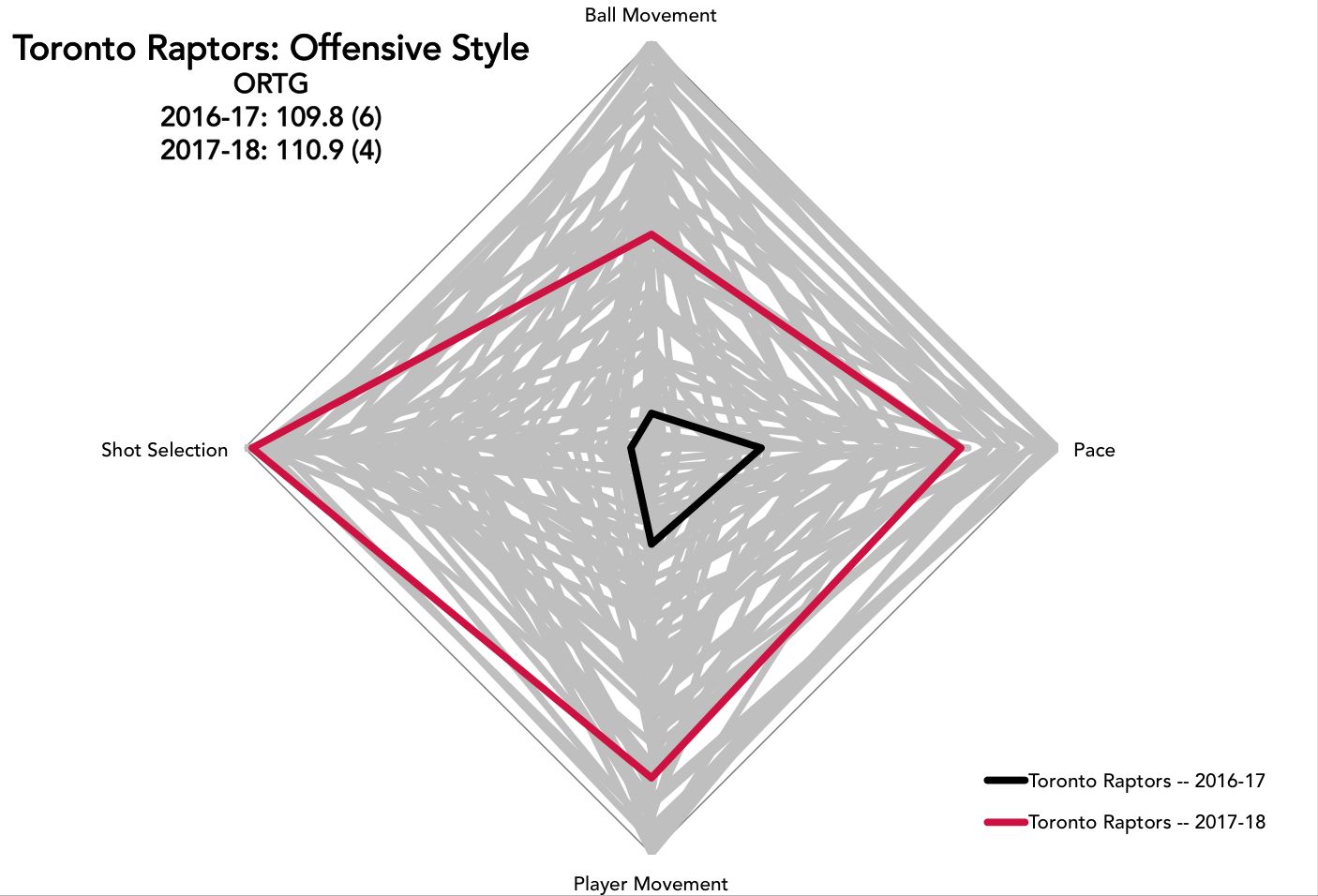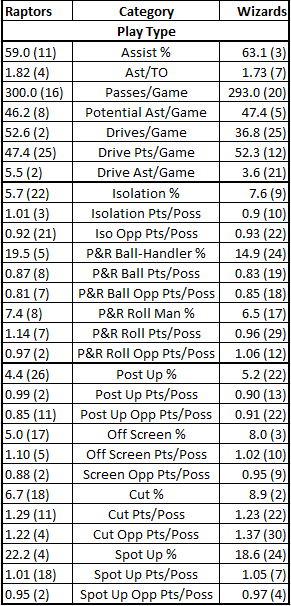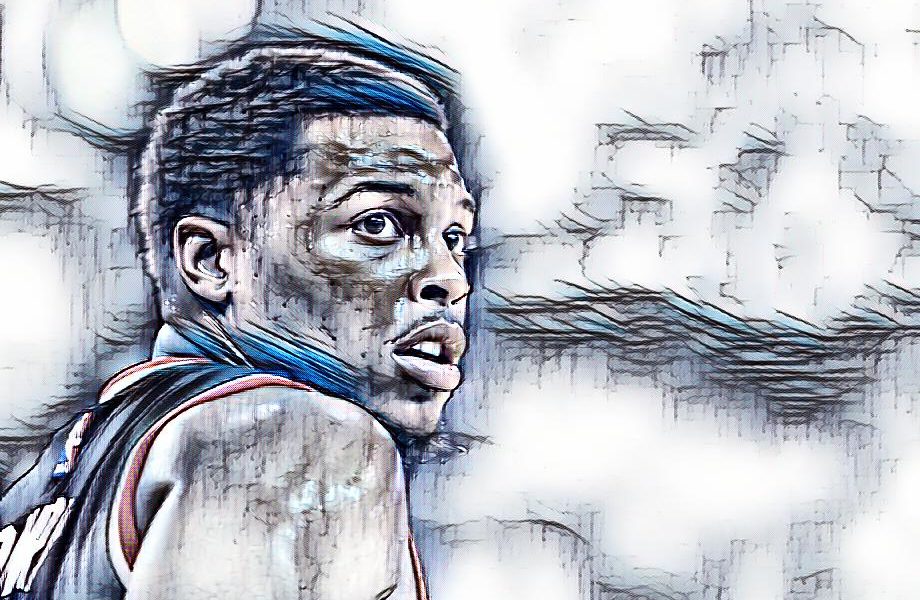The Toronto Raptors will play the Washington Wizards in the first round of the playoffs. The bulk of our preview content will come tomorrow. In the interim, here’s a high-level data dive to get a snapshot of each team over the course of the season.
All of this is strictly descriptive, and obviously the absence of John Wall for a large chunk of the season hangs over everything on the Wizards’ side. Dwane Casey and Scott Brooks will tweak their base strategies for the opponent, personnel may dictate rotation tweaks, and, as always in a short-ish seven-game series, there will be ample room for variance. Consider this just a first sweep of how the two teams performed during the regular season.
Schedule
Rotations & Lineups
Toronto: Everyone has a good idea of what to expect from the Raptors by now. They run 10 deep, will comfortably play two more as the situation calls for it, and their all-bench unit and starting lineup have been two of the most successful groups in the league. The big questions Casey faces are whether – and when – to use his matchup pieces in Norman Powell and Lucas Nogueira and how short a leash to give the all-bench group if they struggle. Here’s a quick look at how the Raptors fared individually this year, down the stretch, and against the Wizards:
And here’s a look at how the Raptors’ rotations played out this year, per NBARotations.info:
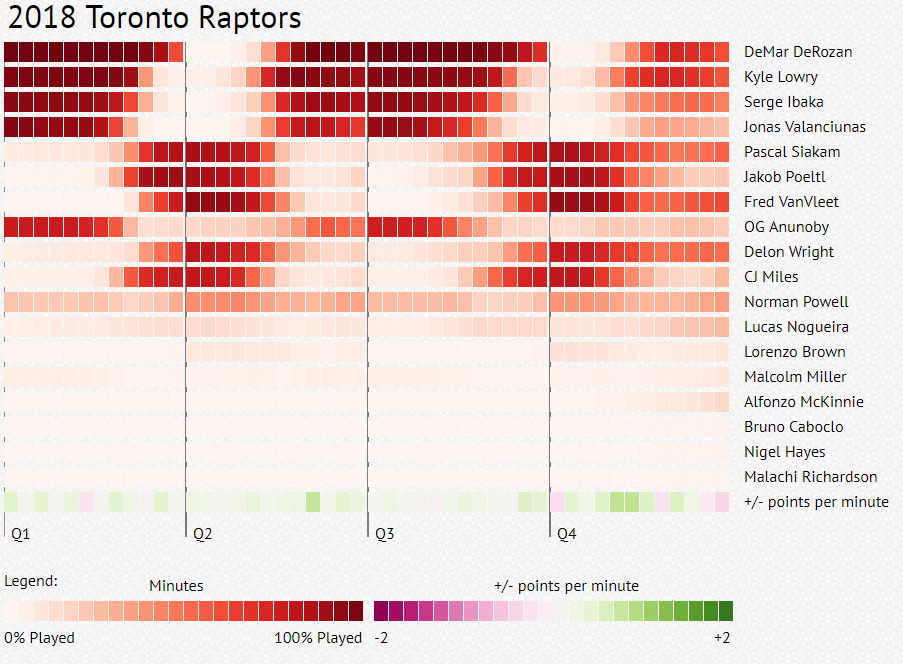 Washington: The Wizards have more questions still to answer following the return of John Wall. Four games is hardly a great sample to judge off of, and while the extra rest the playoffs provide should mean he plays in every game, there are rotation tweaks to figure out. Washington’s depth hasn’t been it’s strength this year, but they’ve been more solid than maybe anticipated, and it seems likely that (barring the health of Mike Scott) Brooks could tighten his rotation to nine rather than continuing to trot out a fourth ineffective guard. Here’s a quick look at how the Wizards fared individually this year, down the stretch, and against the Raptors:
Washington: The Wizards have more questions still to answer following the return of John Wall. Four games is hardly a great sample to judge off of, and while the extra rest the playoffs provide should mean he plays in every game, there are rotation tweaks to figure out. Washington’s depth hasn’t been it’s strength this year, but they’ve been more solid than maybe anticipated, and it seems likely that (barring the health of Mike Scott) Brooks could tighten his rotation to nine rather than continuing to trot out a fourth ineffective guard. Here’s a quick look at how the Wizards fared individually this year, down the stretch, and against the Raptors:
And here’s a look at how the Wizards rotations played out this year:
Also, the Wizards signed Ty Lawson today, and I have no idea what to do with that information.
Overall Performance
There’s not a whole lot to say here that doesn’t come with applicable caveats. The Raptors were better than the Wizards more or less across the board this year, finishing as the only team in the NBA in the top five on both ends of the floor. Washington, meanwhile, was roughly average, and while there’s certainly under-performance there due to John Wall missing significant time, they also didn’t perform to their expectations with Wall, either. The Wizards also stumbled down the stretch, so unless you subscribe to the idea that the Wizards were playing 3-D chess to get to draw the Raptors and the Cavaliers in the first two rounds, it doesn’t look like Wall’s return steered them out of it entirely.
Still, this is a dangerous team, with two All-Star guards, a tremendous do-everything role-playing wing, and a deep-ish frontcourt. Washington doesn’t have any glaring high-level weaknesses outside of their penchant for fouling, and there’s a sense their ceiling is much higher than that of a normal eighth seed. Their floor is probably also a lot lower given the rumored in-fighting and if Wall still isn’t 100 percent.
(League rank in parentheses, per NBA.com.)
Shot Spectrums
A huge focus for the Raptors all year on the offensive end has been changing their shot selection such that threes are valued more heavily and low-efficiency mid-range shots fall to the wayside. They’ve largely accomplished that, with only DeMar DeRozan and Serge Ibaka shooting from the high mid-range with any frequency and the team ratcheting up their 3-point volume as a team. The Wizards don’t have the kind of defensive identity that will necessarily disrupt that – they allow roughly an average frequency of looks both at the rim and from outside. One area Washington has thrived defensively is keeping opponents to a tidy 3-point percentage, and while this is something that defenses have been shown to have little control over, length at every position would probably be the one way a team could regularly effect an opponent’s ability to hit from outside. How Washington approaches DeRozan and how he responds to that pressure will be a little more interesting than just where the team’s shot locations end up.
(Shot charts via AustinClemens.com.)
The other end of the floor is far more intriguing, as the Wizards seem uniquely suited to attack Toronto’s pick-and-roll scheme. The Raptors have tweaked their scheme this year, asking their centers to drop further back in the pick-and-roll while their guards fight over screens and recover to contest. The hope was to cut down on the amount of help necessary on pick-and-rolls, which would allow the Raptors to better stay at home on shooters. It would also invite more mid-range attempts from opponents. It was quite successful – the Raptors were a top-five defense, did better than almost anyone limiting opponent threes, and defended well at the rim despite inviting more attempts there. Washington will take what the Raptors give in that regard – they ranked near the bottom of the league in volume at both the rim and beyond the arc, instead feasting on those lower-efficiency but much easier to come by mid-range looks (they ranked top 10 in short- and long-mid-range volume and field-goal percentage).
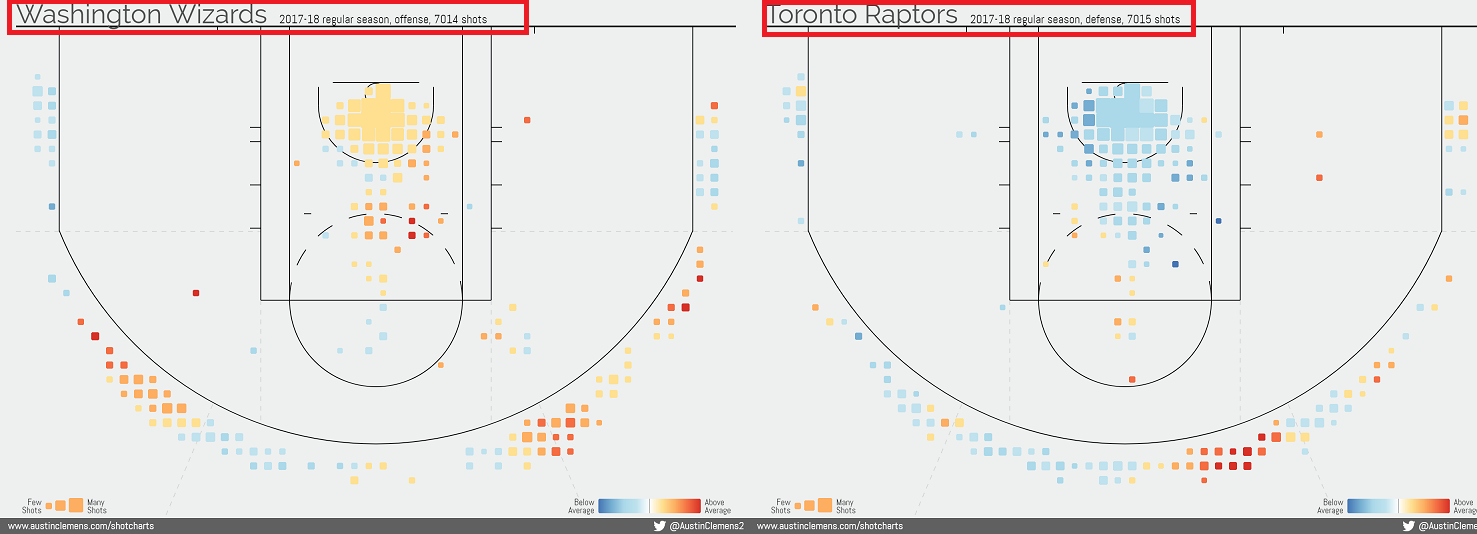 Wall, in particular, presents an interesting test to the Raptors’ pick-and-roll scheme. At full health, he’s probably the guard in the Eastern Conference best suited to exploit the opportunities it presents, and if the Raptors adjust and send extra help his way, there are few better at picking out corner shooters. What will be interesting to see is just how much playmaking duty Bradley Beal takes on, as Beal grew significantly with Wall out and carried a heavy load in each of the four meetings with Toronto. Washington’s offensive identity is confused a little bit in that regard, as they played drastically different with Wall sidelined.
Wall, in particular, presents an interesting test to the Raptors’ pick-and-roll scheme. At full health, he’s probably the guard in the Eastern Conference best suited to exploit the opportunities it presents, and if the Raptors adjust and send extra help his way, there are few better at picking out corner shooters. What will be interesting to see is just how much playmaking duty Bradley Beal takes on, as Beal grew significantly with Wall out and carried a heavy load in each of the four meetings with Toronto. Washington’s offensive identity is confused a little bit in that regard, as they played drastically different with Wall sidelined.
(League rank in parentheses, per CleaningTheGlass.com.)
Playing Style
There has been no better capture of the Raptors’ drastic shift in playing style than this chart from Ian Levy at Nylon Calculus, displaying the change in pace, ball movement, and improved shot selection. This is a dramatically different Raptors team:
The Wizards have changed far less from last year, slowing down their pace some, adding a bit more ball movement, and slightly improving their shot selection. This is still largely a team built similar to older Raptors teams, though, where the singular abilities of the individuals carry far more weight than what precedes a shot.  The Raptors’ reliance on isolation in the past was always a little overstated, and they’re safely in the bottom 10 for isolation frequency now, even though they’re still among the best scoring through those means. Instead, Toronto leans heavily on the pick-and-roll, ranking in the top 10 in frequency and efficacy for both the ball-handler and roll-man (they’re also in the top 10 defending each). Toronto’s post-up diet consists mostly of improvised looks out of other actions, and the removal of clear-it-out dump-ins has helped Toronto become one of the best post-up teams in the league when they do use them. The Raptors still drive to the rim more than almost anyone, too, they’re just looking to pass out of those drives a little more often rather than getting right to the rim or to the line. Defensively, Toronto doesn’t have a clear play-type weakness, though they’re a little below average guarding in isolation. This is a pretty well-balanced attack on both sides of the ball.
The Raptors’ reliance on isolation in the past was always a little overstated, and they’re safely in the bottom 10 for isolation frequency now, even though they’re still among the best scoring through those means. Instead, Toronto leans heavily on the pick-and-roll, ranking in the top 10 in frequency and efficacy for both the ball-handler and roll-man (they’re also in the top 10 defending each). Toronto’s post-up diet consists mostly of improvised looks out of other actions, and the removal of clear-it-out dump-ins has helped Toronto become one of the best post-up teams in the league when they do use them. The Raptors still drive to the rim more than almost anyone, too, they’re just looking to pass out of those drives a little more often rather than getting right to the rim or to the line. Defensively, Toronto doesn’t have a clear play-type weakness, though they’re a little below average guarding in isolation. This is a pretty well-balanced attack on both sides of the ball.
Conversely, the Wizards are a little more isolation-heavy than the Raptors despite having the third-highest assist percentage in the league. The Wizards’ high assist rate is almost a paradox given how infrequently they look to pass out of drives or use their roll men in the pick-and-roll, but few teams are better at finding cutters and players coming off of screens. Anecdotally, it feels like the Raptors have more trouble guarding on the ball than off of it, and a look at the numbers shows that’s not really accurate. Still, the return of Wall allows Beal to become an even greater off-ball threat, whirring through a forest of beefy screen-setters, and whoever shares that responsibility (OG Anunoby to start games, a committee off the bench) will have an exhausting assignment. Defensively, Washington’s only clear play-type weakness is defending in the post, and even then, Marcin Gortat ranks in the 74th percentile individually.
(League rank in parentheses, per NBA.com.)
Clutch & Miscellaneous
Want some good news? Washington was one of the only playoff teams even worse than the Raptors in the clutch this year. The Raptors’ clutch issues were to some degree a matter of perspective – their performance in the last five minutes of games within five points was shaky, but they also pulled away in a lot of those scenarios, limiting the sample and giving them a strong record in games that were at some point in the clutch. Washington, meanwhile, was just plain bad, both in the clutch and in fourth quarters in general. Maybe Wall helps there on sheer talent; there were also a few instances this year where the Wizards with Wall were guilty of the same things offensively that the Raptors and DeRozan have been criticized for late in games.
Looking elsewhere quickly, neither team has a clear edge in some of the miscellaneous categories there’s data for, as both score fairly well off of opponent turnovers, on the fast break, and in transition in general. The Wizards probably get the edge in the open court when Wall’s on the floor, while the Raptors’ bench is a little better suited to that type of game than Washington’s. Toronto’s edge comes in the paint, where they scored significantly more than Washington this year, since the Wizards don’t use their bigs a ton and are more open to mid-range shots. From a hustle perspective, both teams get after it fairly well in the deflections and charges departments, while the Raptors do a better job of contesting field goals through a broad lens.

(League rank in parentheses, per NBA.com.)
Individual Matchups
This is where the lack of Wall in the four meetings between the two teams really hurts. There is what would otherwise be a decent in-season sample – regular season outcomes are at least a little helpful, statistically, in predicting first-round series, even though four games is a tiny sliver of far more predictive full-season data – but Wall missed four meetings and three rotation Raptors missed at least one game each. We don’t know for sure, then, who will guard whom as it relates to Wall at both ends of the floor. We can at least try to get a look at how some of the matchups might breakdown using NBA.com’s new Matchup tool.
A caveat: Grains of salt are required here, as it’s usually unfair to assign credit and blame to one individual defender on a given play, and because classifying who the primary defender was is simply based on time spent guarding. These numbers can’t account for the interconnectedness of team defense, any miscues elsewhere on the floor on a play, or what was supposed to happen for either side. Primarily, they can give us a look at who was responsible for guarding who most often.
What follows are the most common offensive and defensive matchups from the regular-season series, color-scaled such that green is good for the Raptors and red is bad:
(“Player Pts Diff” = points relative to player’s average over 100 possessions; negative is better for the defender…”Team Pts Diff” = points relative to team’s average over 100 possessions; negative is better for the defensive team…”Det Factor” = field-goal attempts per-100 possessions relative to a player’s average; a number below one means the defender has deterred the offensive player from shooting.)
Some quick thoughts:
- On paper, Porter is the type of defender who can give DeRozan trouble. Length has always been his biggest deterrent, and while Porter’s impact here is modest – the Raptors actually scored slightly better, even with DeRozan scoring a bit less – it figures to be the matchup they most try to scheme around, getting DeRozan switches or finding ways to exploit any extra help the Wizards send to that match-up. On paper, Kelly Oubre should present some similar challenges, but DeRozan’s gotten what he needs to against The Wavy One without much issue.
- At the other end, DeRozan makes the most sense on Porter. Porter’s a good player, but he suits what DeRozan can do defensively since he’s strong enough to guard against Porter’s post-ups and Porter doesn’t have a high usage rate.
- The Wizards will feed Gortat, knowing how he’s performed against Valanciunas in the past. He shoots 20 percent more often when Valanciunas is guarding him, and Washington’s offense went through the roof. The Raptors really go away from Valanciunas, too, as Gortat has made life tough for him. This still doesn’t make a lot of sense. Valanciunas is much, much better than he’s shown historically against Gortat. It’s weird.
- Serge Ibaka hasn’t had any luck with Markieff Morris at either end. These last two notes highlight some of the difficulty the starting lineup has had. He has to be better than Morris.
- OG Anunoby and Norman Powell saw the most time on Bradley Beal, and Anunoby figures to again here. Powell did the better job in the given sample (significantly so), but Anunoby’s been back to defending quite well again of late and Powell might be on the outside of the playoff rotation. Pascal Siakam and Delon Wright are also candidates to get some time on Beal.
- Kyle Lowry was fairly passive in these matchups, seeing roughly equal time opposite Beal, Tomas Satoransky, and Tim Frazier. Lowry is going to have to be aggressive on offense, especially if the Wizards manage to slow DeRozan down and take the ball out of his hands, and he’ll be guarding either Beal or Wall or both. This is a big Lowry series. If he can win the point guard battle, the Raptors should have enough at every other position to handle their business.
Lineups
Here are the six Raptors lineups that played at least 100 minutes together this year, as well as how they performed against Washington:
That’s a lot of small numbers! The Raptors had five high-performing, moderate-to-high usage groups during the regular season – a testament to Casey’s rotations, by the way – and exactly one of them has seen minutes against Washington. The four-game sample between the teams really isn’t very helpful from a lineup perspective. To wit, here are Washington’s most-used lineups this year and how they performed against Toronto:
None of those games contained Wall, Tim Frazier is mostly out of the rotation now, and with Wall back, Satoransky probably won’t play with the starters much. That leaves the Satoransky bench unit, and Brooks might ditch a 10th man in the rotation anyway to keep one of Wall or Beal on the floor.
Conclusions
How you feel about this matchup probably comes down to three things: How much you trust a full-season sample, how shook you remain from a sweep three years ago, and how much stock you put in small matchup samples. Based on the entire season, the Raptors should be heavy faovrites. They were better than Washington in most meaningful categories and were the third-best team in the league on balance. It would be nearly unprecedented, from a purely statistical perspective, for a team this good to be knocked out in the first round. At the same time, the Wizards feel like they’ve had a psychological edge on the Raptors despite a 14-4 regular season mark over the last five years thanks to that sweep. Splitting four Wall-less games this year probably didn’t help. At the very granular level, there wasn’t a ton to glean from those four games that wasn’t already fairly plain on paper, and so Game 1 should be a pretty big “learning” game for all of us.

